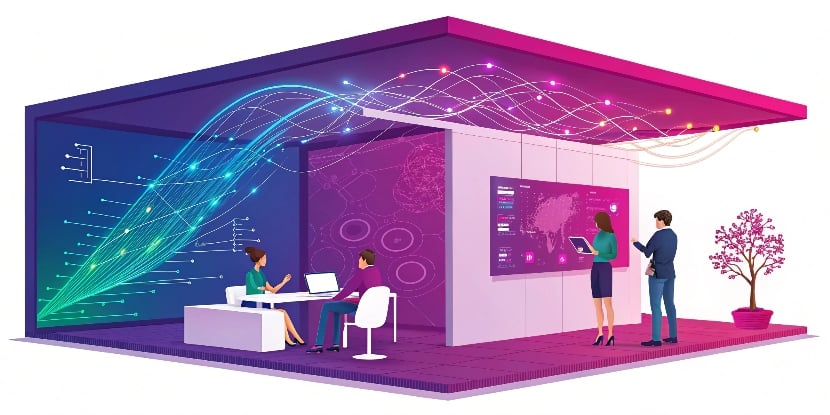Navigating AI Copyright Laws: Implications for Businesses
In today's tech-driven world, AI is reshaping creative content and intellectual property (IP). As AI-generated outputs become more common, businesses must navigate complex legal landscapes to protect their assets. This post explores AI copyright laws, the impact of AI-generated code on company valuation, and strategies for safeguarding IP in an AI-driven era. These insights are based on current industry studies and market reports.
Understanding AI Copyright Laws
The U.S. Copyright Officecopyright.govstates that copyright protection requires human authorship. AI can enhance creativity, but only works with significant human input qualify for legal protection. Emerging technologies and potential legislative changes could alter these dynamics. When AI augments human creativity, the resulting work can secure copyright protection through its human-authored elements. However, if the creative process relies too heavily on automation, it may not be legally protected. This distinction is crucial for defining which elements of a company's creative output are protected.
AI-Generated Code and IP Valuation
AI-generated code is changing company valuations. As more firms use AI in software development, understanding protectable IP is crucial. It's important to clarify what "significant human input" means, especially in borderline cases. Courts often face challenges in distinguishing between AI-assisted and fully AI-generated work, adding complexity to the legal landscape.
Reduced Copyright Eligibility
Under current U.S. copyright law, code produced entirely by AI—without human creative input—is not eligible for copyright protection. This means that if a significant portion of your codebase is generated without meaningful human intervention, it may not qualify as an original work.originality.ai
Investor Risk Perception
- Infringement Liability: AI models trained on vast datasets—including copyrighted materials—can expose companies to legal challenges. The potential for litigation is a critical factor for investors evaluating companies that rely heavily on AI-generated code.
cio
- Replicability and Competitive Risk: Without robust legal protection, AI-generated code is vulnerable to replication by competitors, potentially eroding a company's market advantage. Firms with ambiguous IP ownership of their code may face valuation discounts compared to those with clearly demarcated, human-authored code.
forbes
Mitigation Strategies for IP Value
Given the risks associated with AI-generated content, businesses must adopt strategies to ensure their intellectual property remains secure and valuable. For recommendations like detailed contractual safeguards, it's advisable for companies to work with specialized legal counsel to tailor strategies to their specific contexts.
1. Rigorous IP Audits & Documentation
- Tracking Contributions: Implement systems to track the balance between AI-generated and human-authored code. Document creative decisions during code reviews to establish clear human authorship.
bradley
- Patent Novel Methodologies: Secure patents for innovative AI training methodologies and integration techniques to safeguard proprietary processes and enhance competitive advantage.
mintz
2. Hybrid Development Frameworks
- Optimizing AI Use: Structure development workflows so that AI is used for routine tasks, while human developers focus on unique algorithms and innovative features. This hybrid approach ensures substantial human input secures intellectual property protection and reduces legal risks.
computerlaw
- Integrative Oversight: Ensure final outputs are a blend of AI-generated drafts and human innovation, meeting the "significant human input" threshold for legal protection.
3. Robust Contractual Safeguards
- Vendor Agreements: Negotiate strong IP warranties in contracts with AI vendors to secure clear ownership rights and include liability clauses for potential infringement issues.
bloomberg
- Contributor License Agreements (CLAs): Use CLAs that define the rights and responsibilities for AI-assisted contributions, ensuring clarity and protection for all parties.
Conclusion: Balancing Innovation with IP Protection
AI is reshaping creativity and intellectual property, but true value still hinges on human ingenuity. As legal standards evolve, businesses must proactively manage their IP portfolios—ensuring that significant human input remains at the heart of every innovation.
Embrace strategic documentation, hybrid development models, and robust contractual safeguards to transform potential liabilities into high-value assets. In this blurred landscape of human and machine creativity, the future belongs to those who lead with deliberate, human-driven direction. Now is the time to secure your competitive edge.
Additional Resources
- AI and Intellectual Property Rights - Dentons
dentons
- IP Considerations for AI Companies - Paul Hastings
paulhastings
- Generative AI: Copyright and Ownership - Originality.ai
originality.ai
- Protecting AI-Generated Code - Computer Law
computerlaw
By embracing a strategic blend of human ingenuity and advanced AI technologies, modern businesses can not only navigate the legal complexities but also drive transformative innovation and sustainable growth.
Ready to Navigate AI Copyright?
Want to learn more about protecting your IP in the AI era? Explore our blog for deeper insights, or reach out to discuss how we can help safeguard your intellectual property.
Related Articles

The AI Creativity Paradox: Revolutionizing Art or Eroding Culture?
Explore the transformative impact of generative AI on art and creativity. From AI-generated masterpieces to ethical concerns, discover how this technology is reshaping cultural expression and creative industries.

AI Integration Roadmap for Small Businesses
Discover the ultimate step-by-step AI integration roadmap for small businesses. Learn how to assess your needs, select the right tools, pilot projects, integrate AI into daily operations, and continuously optimize for growth and efficiency.